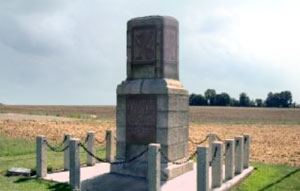Caen
Baron-sur-Odon
Hill 112 (10th July - 23rd July 1944)
Hill 112 was an unimpressive stretch of country covered with wheat two or three feet high, and with a few wooded copses and several villages on its slopes. From this elevation the valleys of the Odon and Orne could be seen, and the Germans said, «He who controls Hill 112 controls Normandy».

Certainly they clung to it desperately, and when they were driven off counter-attacked at once to regain possession. Following the failure of Operation Epsom, the 9th and 10th SS Panzer Divisions regained the hill on 29th June, and between then and 23rd July, when they were driven from Maltot, the area around Hill 112 changed hands many times and thousands of Allied and German troops were killed or wounded on its bloody slopes.
The 43rd (Wessex) Division alone lost more than 2,000 men in the first 36 hours of the operation to regain Hill 112. It was reported that the Odon River was dammed with corpses. The attack began before dawn on 10th July with an impressive artillery barrage. By 06:30 hours 129th Brigade (comprising 4th Bn. and 5th Bn. Wiltshire Regt. and 4 Bn. Somerset Light Infantry), had advanced through the waist-high wheat sprinkled with poppies. They reached their objectives at the crest of the hill, although for several hours fierce close-quarter battles continued in the wheat where SS troops manned concealed machine-gun nests and refused to surrender even when wounded.
The task of 130th Brigade was to capture the villages of Eterville and Maltot, after which 214th Brigade was to exploit with an armoured brigade to the Orne. From a firm base provided by 5th Dorsets, the 4th Dorsets launched a successful attack on Eterville, and at 08:15 hours 7th Bn. Royal Hampshire Regt. attacked Maltot, initiating what has been called «a battle of shattering intensity even by the standard of Normandy». SS panzer troops supported by dug-in and concealed Tiger tanks held an almost impregnable position, and even when the Royal Hampshires were reinforced by 4th Dorsets no progress could be made. Among the many casualties were five company commanders. From Eterville 5th Bn. Dorsetshire Regt and 7th Bn. Somerset Light Infantry held off savage counter-attacks, as did 5th Bn. Wiltshire Regt. and 4th Bn. Somerset Light Infantry during the day. By 15:00 hours it was clear that a fresh attack on Hill 112 was needed, but of the 214th, the reserve brigade, two battalions had already been committed, leaving only 5th Bn Duke of Cornwall's Light Infantry (DCLI).
So with 4th Somerset LI as a firm base 5th DCLI launched an attack at 22:30 hours with two companies up front. The crest of the hill was reached and the battalion consolidated in a wood, which was later called «Cornwall Wood», just in time to meet savage counter-attacks from the 9th SS Panzer Division. In fighting that continued all night, 10 counter-attacks were beaten off, but when battalion commander was killed and most of the officers and NCO's killed or wounded, the remnants of the DCLI withdrew. The CO of 4th Somerset LI formed the survivors into two companies and sent them back to the wood for what has been called «the death struggle of 5th DCLI» The final overwhelming attack left about 75 survivors, approximately 10 percent of the original strength of the battalion. After the battle, all battalions of the 43rd Division required reinforcements, which, in effect, produced new battalions. Within two weeks 5th DCLI was back at full strength and in action on Hill 112, and 4th Somerset LI required reinforcements of 19 officers and 479 other ranks.
The enemy suffered equally with the 9th SS Panzer Division, also suffering very heavy causalities that during the battle for Hill 112, with its infantry companies being reduced to five or six men each. On 29th July when Maltot was at last captured by 4th and 5th Wiltshires, and it was found that the dead of the Dorsets and Royal. Hampshires, who had fallen on 10th July, were still lying in heaps around partly dug slit trenches and in streets and fields.